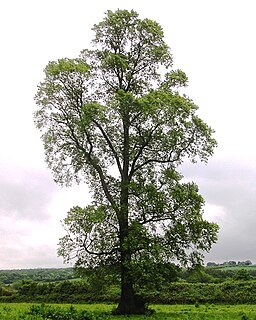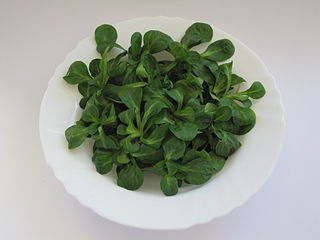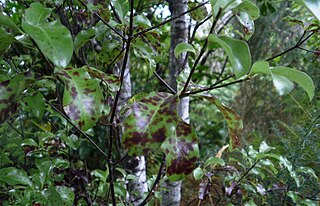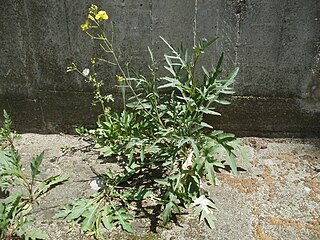
Elms are deciduous and semi-deciduous trees comprising the flowering plant genus Ulmus in the plant family Ulmaceae. The genus first appeared in the Miocene geological period about 20 million years ago, originating in what is now central Asia. These trees flourished and spread over most of the Northern Hemisphere, inhabiting the temperate and tropical-montane regions of North America and Eurasia, presently ranging southward across the Equator into Indonesia.

Galls or cecidia are a kind of swelling growth on the external tissues of plants, fungi, or animals. Plant galls are abnormal outgrowths of plant tissues, similar to benign tumors or warts in animals. They can be caused by various parasites, from viruses, fungi and bacteria, to other plants, insects and mites. Plant galls are often highly organized structures so that the cause of the gall can often be determined without the actual agent being identified. This applies particularly to some insect and mite plant galls. The study of plant galls is known as cecidology.

The hummingbird hawk-moth is a species of moth. It was first described by Carl Linnaeus in his 1758 10th edition of Systema Naturae. As of 2018, its entire genome and mitogenome have been sequenced.
The Valerianaceae Batsch, the valerian family, was a family of flowering plants that is now considered part of the Caprifoliaceae. Plants are generally herbaceous, and their foliage often has a strong, disagreeable odor. They are found native in most regions of the world except for Australia. Some species are cultivated as ornamentals or used in herbal medicine for inducing relaxation and sleep.

Campanula is one of several genera in the family Campanulaceae with the common name bellflower. It takes both its common and its scientific name from its bell-shaped flowers—campanula is Latin for "little bell".

Quercus douglasii, known as blue oak, is a species of oak endemic to California, common in the Coast Ranges and the foothills of the Sierra Nevada. It is California's most drought-tolerant deciduous oak, and is a dominant species in the blue oak woodland ecosystem. It is occasionally known as mountain oak and iron oak.

Valerianella locusta is a small annual plant that is eaten as a leaf vegetable. It has a characteristic nutty flavour, dark green colour, and soft texture, and is popularly served as salad greens. Common names include corn salad, common cornsalad, lamb's lettuce, mâche, fetticus, feldsalat, nut lettuce, field salad, and rapunzel. In restaurants that feature French cooking, it may be called doucette or raiponce, as an alternative to mâche, by which it is best known. In German-speaking Switzerland it is known as Nüsslisalat or Nüssler, terms that have been borrowed by the area's many English-speakers. It is typically served as a salad with chopped hard-boiled eggs and crumbled bacon.

Citrus greening disease is a disease of citrus caused by a vector-transmitted pathogen. The causative agents are motile bacteria, Candidatus Liberibacter spp. The disease is vectored and transmitted by the Asian citrus psyllid, Diaphorina citri, and the African citrus psyllid, Trioza erytreae, also known as the two-spotted citrus psyllid. It has also been shown to be graft-transmissible. Three different types of HLB are currently known: The heat-tolerant Asian form, and the heat-sensitive African and American forms. The disease was first described in 1929 and first reported in China in 1943. The African variation was first reported in 1947 in South Africa, where it is still widespread. Eventually, it affected the United States, reaching Florida in 2005. Within three years, it had spread to the majority of citrus farms. The rapid increase in this disease has threatened the citrus industry not only in Florida, but the entire US. As of 2009, 33 countries have reported HLB infection in their citrus crop.

Aesculus hippocastanum is a species of flowering plant in the soapberry and lychee family Sapindaceae. It is a large deciduous, synoecious (hermaphroditic-flowered) tree, commonly known as horse-chestnut or conker tree.

Centranthus ruber, also called red valerian, spur valerian, kiss-me-quick, fox's brush, devil's beard and Jupiter's beard, is a popular garden plant grown for its ornamental flowers.

Ilex aquifolium, is a species of holly native to western and southern Europe, northwest Africa, and southwest Asia. It is regarded as the type species of the genus Ilex, which by association is also called "holly". It is an evergreen tree or shrub found, for example, in shady areas of forests of oak and in beech hedges. In the British Isles it is one of very few native evergreen trees. It has a great capacity to adapt to different conditions and is a pioneer species that repopulates the margins of forests or clearcuts.

Ulmus 'New Horizon' is an American hybrid cultivar raised by the Wisconsin Alumni Research Foundation (WARF), from a crossing of the Japanese Elm clone W43-8 = 'Reseda' with Siberian Elm clone W426 grown from seed collected from a street tree at Yankton, South Dakota. 'New Horizon' was patented in the US in 1994, while in Europe, it is marketed as one of the 'Resista' elms protected under E U breeders' rights.

Pittosporum tenuifolium is a small evergreen tree – up to 10 m (33 ft) – commonly known as kōhūhū and black matipo, and by other Māori names kohukohu and tawhiwhi. Its small, very dark, reddish-purple flowers generally go unnoticed, and are scented only at night. The Latin tenuifolium means "slender-leaved"

Cephalotaxus harringtonii, commonly known as Japanese plum-yew, Harrington's cephalotaxus, or cowtail pine, is a coniferous bush or small tree in the family Taxaceae. It is native to Japan, but is occasionally utilised in western gardens and several cultivars exist for these purposes. Japanese plum yew has been in cultivation in Europe since 1829, and many modern horticulturists are familiar with this Japanese species, named in honor of Charles Stanhope, 4th Earl of Harrington, one of the first to grow the plant in a European garden, at Elvaston.

Diplotaxis tenuifolia is a species of flowering plant in the mustard family known by the common name perennial wall-rocket. This plant is native to Europe and Western Asia. It can be found throughout much of the temperate world where it has naturalized.
The African citrus psyllid is a sap-sucking insect, a hemipteran bug in the family Triozidae. It is an important pest of citrus, being one of only two known vectors of the serious citrus disease, huanglongbing or citrus greening disease. It is widely distributed in Africa. The other vector is the Asian citrus psyllid, Diaphorina citri.

Trioza is a genus of sap-sucking bugs in the family Triozidae.

Bactericera albiventris is a hemipteran bug in the family Triozidae, which causes galls on the leaves of willows. It was first described by Arnold Förster in 1848.

Phyllocoptes goniothorax is a species of mite belonging to the genus Phyllocoptes, which causes galls on the leaves of hawthorns. It was first described by Alfred Nalepa in 1889.
Trioza eugeniae or the syzygium leaf psyllid, lillypilly psyllid, and eugenia psyllid is a sap-sucking hemipteran bug in the family Triozidae which creates galls on the leaves of Syzygium paniculatum. This species is native to Australia and has been introduced into California.

















